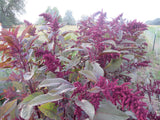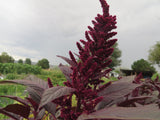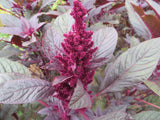Quick facts
- Easy to grow plant of many uses!
- Adds a lot of color to the garden landscape
- Nutritious
- Easy to make into porridge
- Great as crackers
Amaranthus sp.
40 days to leaf, 90 to grain. Delightful plant of many uses! Amaranth is traditionally eaten when the leaves are young or as an iron-rich grain when fully mature, is used as a dye plant, or is harvested as a long-lasting cut flower. We love the deep red of 'Hopi Red Dye' and feel that it just adds so much to the garden landscape. This one is tall, between 4-5 ft. When used as a cut flower, amaranth heads keep their color for a long time. Seeds are easy to harvest.
We love to make amaranth porridge. We add butter or olive oil, milk, dried fruit, or a nut butter. We also have recently gotten into making amaranth crackers. Check out this great recipe for amaranth crackers from IndigiKitchen. We love exploring other herbal and sweet additions to these like rosemary, honey, nutmeg... The possibilities are endless.
More about amaranth-
Amaranth is a unique and ancient grain native to the Americas. It was a staple food of the Aztecs, Inca, and Mayan and was first cultivated in 8,000 BC. It is still of huge importance in Central America, where it thrives not only as a resilient, low impact staple food but as spiritual symbol of cultural thriving.
We have followed the work of the non-profit Garden's Edge ever since being introduced to their work at the Santa Rosa Heirloom Festival in 2014. Working in Guatemala, Garden's Edge "supports sustainable agriculture, micro-enterprise, and education in rural communities in order to revitalize cultural knowledge and improve economic well-being." Central to their work is amaranth, as they assist indigenous communities in preserving local amaranth varieties that are vulnerable due to colonization and civil war. Please learn more about their work with indigenous communities and amaranth, and find traditional recipes, HERE.
We grow amaranth because it simply thrives in our hot, dry, summers and we want to promote it as a low-impact, high nutrition plant for a changing world. The grain separates quite easily from the plant when ripe, and can easily be winnowed in a light wind.
Eat the tender young leaves, pop the grains, or make a nutrient dense porridge. The possibilities are really endless. Find Josselin Chun's recipe for Amaranth Torta here! Amaranth is resilient and easy to grow, and the 2 varieties we grow mature well in our short season climate. It's tall and vigorous and easily outcompetes weeds- so its great for organic gardens.
For more information, we LOVED this article from Edible New Mexico about amaranth.
How to grow it:
|
Germ Temp |
Indoor Start |
Germ Days |
Frost Tolerant |
Sun |
Seed Depth |
Plant/Row Spacing |
| 60-85F |
5 weeks |
7-14 d. |
No |
Full to part shade |
1/8” |
12”/12” |
|
We prefer to start amaranth in pots indoors in early April for planting out in May or June after danger of frost has passed. Alternatively, direct sow after last frost date, covering lightly. Thin to 12 inches between plants. Harvest amaranth heads in August once black seeds start to fall- be sure to cut them before too many fall! Harvest into a bag, beat or stomp on the bags to free the seeds from the head, and use screens or fans to separate seeds from chaff. Seed specs: Packet size- 1/2 g., ~500 seeds
|







